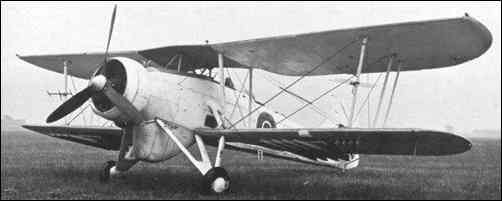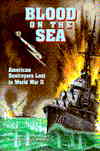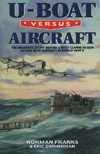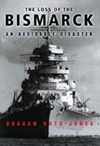Fighting the U-boats
Aircraft & Air forces
Fairey Swordfish
prepared by Emmauel Gustin

A Fairey Swordfish Mk.III with ASV Mk.XI radar between its wheel legs, dipole arrays on its wings struts, and rocket launching rails under the wings.
One of the most unusual combat aircraft of World War II was the Fairey Swordfish. It was a big, unsophisticated biplane, slow and cumbersome. It looked antiquated, because it was, but it served until the end of the war and survived its intended replacement. Initially, Swordfishes operated from the large fleet carriers. Later Swordfishes operated from escort carriers, and were very effective against U-boats. The nickname Stringbag indicated the versatility of the Swordfish, which could carry an unlikely combination of loads, but also referred to its jungle of bracing wires, which belonged to a past age.
The precursor of the Swordfish, the Fairey PV, was designed by Marcel Lobelle as a private venture to meet an order from the Greek Navy, which wanted a torpedo-bomber and spotter-reconnaissance aircraft. The PV was similar to a design that had been offered to meet Air Ministry requirement S.9/30 for an unarmed spotter-reconnaissance aircraft, but had an Armstrong Siddeley Panther radial engine instead of a liquid-cooled Rolls-Royce Kestrel. The prototype PV made its first flight on 21 March 1933. After modifications and replacement of the engine by a Bristol Pegasus IIM radial, it was called the TSR.1 (TSR for Torpedo-Spotter-Reconnaissance). It flew in this form in July 1933, but was lost in September.
The design team then produced a modified aircraft, designated TSR.II. The wings were slightly swept back to correct the center of gravity position, and the fuselage was made longer. The TSR.II met the requirements of specification S.15/33, which had superseded S.9/30 in the mean time, and called for a type that could serve as two-seat torpedo-bomber and three-seat reconnaissance aircraft. The TSR.II flew on 17 April 1934. On 23 April 1935, Fairey received a production order. The Swordfish entered service when monoplane carrier aircraft were already appearing, and although performance exceeded expectations, it was not spectacular. The first aircraft reached service units in 1936.
The Swordfish was a large biplane, but because it is single-engined it tends to look deceptively small from a distance and on photographs. Its fabric-covered metal construction was sturdy and reliable, but lacked refinement. The biplane wing had ailerons on both lower and upper planes, and leading edge slats on the upper wing. For the take-off, the ailerons could be drooped 8 degrees to increase lift. For storage on carriers, the wing folded backwards. In cold weather the open cockpit was uncomfortable, especially for the rear gunner. The wing struts, the robust fixed landing gear, and the generous size of wings and tail produced high drag, and the single 690hp Pegasus IIIM3 engine gave the aircraft a very modest performance. But it was reliable, which was especially important for the lonely night patrols over the arctic seas that were to be the task of the Swordfish.
The Swordfish was extremely easy to fly and easy to land on a carrier deck, a quality that would become very important for night operations on the small decks of escort carriers. Although the Swordfish was stable around all axes, it could make remarkably short turns. It could also be dived vertically to very close to the sea surface, and then make an abrupt pull-out. Very little speed built up in the dive. Therefore the Swordfish was not necessarily an easy prey for a fighter, but it was during the long, slow and straight run that was required to launch a torpedo.
At the outbreak of war, the Fleet Air Arm had 13 squadrons equipped with Swordfishes, most of them based on the six fleet carriers, and three flights of Swordfishes with floats, that operated from catapult-equipped warships. There was little combat until the German invasion of Norway in the spring of 1940.
Briefly, Swordfishes operated in France, covering the retreat of the British Expeditionary Force. For the months to come, Swordfishes in the Atlantic region conducted mine-laying operations. In the Mediterranean, Swordfishes based on Malta flew anti-shipping strikes, usually at night, against Italian convoys to North Africa. They sank an average of 50,000 tons per month.
In the summer of 1940, after the Franco-German armistice, Swordfishes attacked French ships at Mers-el-Kebir and Dakar. On 11 November, they became famous by the attack on Taranto, where the battleship Littorio was sunk and two others heavily damaged. In May 1941, Swordfishes from HMS Ark Royal crippled the Bismarck. For such an old-fashioned aircraft this was an impressive series of successes. But it ended in February 1942, when six Swordfishes attacked the Scharnhorst, Gneisenau and Prinz Eugen in the channel, and were all shot down. As a torpedo bomber, the Swordfish was quickly replaced by the Albacore, Barracuda and Avenger.
But production of the Swordfish, now built by Blackburn, was increased and the type continued to play a very important role. The Swordfish was now equipped with ASV radar and rocket projectiles for anti-submarine operations. The Swordfish Mk.II had wings with metal-skinned undersides and launching rails for eight 60lb rockets. The provision for a float undercarriage was deleted, and the more powerful Pegasus 30 engine installed. The Mk.III had ASV Mk.XI radar in a big radome between the landing gear legs. This radar had a range of about 40km against ships, and in good conditions also against U-boats; but it would detect a Schnorkel only in very calm seas and at distances below 8km. Some Mk.IIs and many Mk.IIIs became Mk.IVs when a cockpit canopy was installed.
Swordfishes operated from 14 escort carriers and 18 MAC (Merchant Aircraft Carrier) ships. MAC ships were converted oil tankers or grain ships, with a flight deck but minimal maintenance facilities, and the aircraft were continuously exposed to the often appalling weather. For operations from small flight decks with heavy loads, rocket-assisted take-offs were necessary.
In their anti-submarine role, the Swordfishes were very successful. They usually flew patrols at night, patrolling between 145km and 40km ahead of the convoy. Targets were located with radar, and investigated by dropping flares. In September 1944, Swordfishes from HMS Vindex sank four U-boats in one voyage. In total, Swordfishes claimed 22.5 U-boats.
The last Swordfish squadron was No.836, which was disbanded on 21 May 1945, but the last operational mission was flown on 28 June. Total production was 2396 aircraft, including 989 Mk.Is, 1080 Mk.IIs, and 327 Mk.IIIs. Of these two are now airworthy.
U-boats sunk by this aircraft type (Swordfish)
Specifications
Fairey Swordfish Mk.II
750hp Bristol Pegasus 30 radial engine
Wing span 13.92m, length 11.12m, height 3.93m, wing area 56.39m2.
Empty weight 2359kg, max. take-off weight 4196kg.
Max speed 224km/h at 1525m, economic cruise speed 167km/h at 1525m.
Service ceiling 3260m.
Max. range 1658km, range with a torpedo 885km.
Armament: One fixed forward-firing Browning .303 machinegun, and one .303 Vickers K gun in the rear cockpit. An 18-inch torpedo (731kg), a 681kg mine, bombs, or four depth charges could be carried. Racks under the wings for eight 3-inch rockets.
Sources
- Wings of the Navy, by Capt. Eric Brown, published by Jane's, 1980.
- Sub Patrol, by R.S. Young, in Flypast, February 1995.
- Fairey Swordfish: desuet mais efficace, by Alain Marchand, in Le Fana de l'Aviation Nr.291, Fevrier 1994.
- Bob Spence et le Fairey Swordfish, in Le Fana de l'Aviation Nr.280, Mars 1993.
- Airplane Nr.39
Related link
Check out the Swordfish Heritage Trust
Selected media links
|
|
|
|
|







